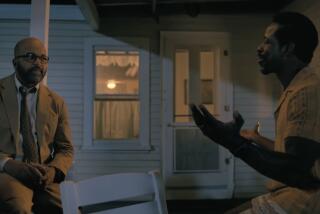Review: Harper Lee’s ‘Go Set a Watchman’ reveals a darker side of Maycomb
- Share via
It would be a mistake to read Harper Lee’s “Go Set a Watchman” as a sequel to her 1960 Pulitzer Prize winning “To Kill a Mockingbird.”
Yes, it takes place a generation after the earlier book, involving a visit from Scout Finch – now 26 and using her given name, Jean Louise – to her hometown of Maycomb, Ala., from New York, where she has gone to live. Yes, Maycomb has changed: Scout’s older brother Jem, we learn in the opening chapter, is dead, victim of a congenitally disordered heart, and her father, Atticus, has not only grown old but also darker and more compromised.
There are references to a trial from the past, during which Atticus defended a black man against charges of raping a white woman: “Consent was easier to prove,” Lee writes, “than under normal conditions — the defendant had only one arm.”
Such a description recalls Tom Robinson, whose trial for a similar offense is at the center of “To Kill a Mockingbird”; “His left arm was fully twelve inches shorter than his right,” the author explains in that novel, “and hung dead at his side. It ended in a small shriveled hand.”
MORE: 23 fiction books you’ll want to read -- and share -- this summer
And yet, those two trials come to very different outcomes; Tom was memorably convicted in “To Kill a Mockingbird,” even with no evidence against him, whereas in “Go Set a Watchman,” Atticus “accomplished what was never before or afterwards done in Maycomb County: He won acquittal for a colored boy on a rape charge.”
That’s just one of many points of divergence or overlap between the novels, which are related in a complicated way.
According to numerous accounts, “Go Set a Watchman” is the earliest version of the manuscript that became “To Kill a Mockingbird,” acquired by Lippincott in 1957 and subjected, under the guidance of editor Tay Hohoff, to what Smithsonian Magazine once called “a title-on-down revision.” What does this mean for us as readers? That we can’t help but engage with “Go Set a Watchman” through a filter of comparison.
Lee introduces us to Maycomb, its history and inconsistencies, as if we have never been here before. We learn, in a passage virtually identical to one in “To Kill a Mockingbird,” of the town’s origin as county seat, after a tavern keeper named Sinkfield “made the surveyors drunk one evening, induced them to bring forward their maps and charts, lop off a little here, add a bit there, and adjust the center of the county to meet his requirements.”
We encounter Atticus’ even-handedness: his insistence on “always [trying] to put himself in his client’s shoes.” In “Go Set a Watchman,” however, this is not a marker of his moral dependability, but rather of his moral corruption.
Corruption? Yes — for this is not the Atticus of “To Kill a Mockingbird.” In “Go Set a Watchman,” he has turned a treacherous corner, aligning with the citizen’s council and the Ku Klux Klan.
“Now think about this,” he tells his daughter. “What would happen if all the Negroes in the South were suddenly given full civil rights? I’ll tell you, There’d be another Reconstruction. Would you want your state governments run by people who don’t know how to run ’em? … We’re outnumbered, you know.”
This is the conflict of the novel, Jean Louise’s struggle to come to some accommodation with a father who is not who she believed he was.
Throughout the first part of the book, Lee builds the tension, drawing us in slowly, revealing the Maycomb her protagonist thought she knew. We visit Finch’s Landing, experience flashbacks to her childhood with Jem and Dill (although not Boo Radley) and meet her on-again, off-again boyfriend, Henry Clinton.
The pace can be, at times, meandering, but the focus appears to sharpen with her discovery, among her father’s reading materials, of a racist tract called “The Black Plague.” “The one human being she had ever fully and wholeheartedly trusted had failed her,” Lee writes, “the only man she had ever known to whom she could point and say with expert knowledge, ‘He is a gentleman, in his heart he is a gentlemen,’ had betrayed her, publicly, grossly, and shamelessly.”
That’s a vivid set-up, and it indicates the promise Hohoff recognized in this draft nearly 60 years ago. Promise, however, remains the operative word, for “Go Set a Watchman” is an apprentice effort, and falls apart in the second half.
Despite its potential for drama, Lee develops her story through long dialogue sequences that read less like conversation than competing arguments. There is little sense of urgency and key aspects of the narrative — Jean Louise’s naïvete, for one thing, her inability to see Maycomb for what it is — are left largely unresolved.
If I’m hesitant to level such a criticism, it’s because, although “Go Set a Watchman” comes marketed as an autonomous novel, it is most interesting as a literary artifact.
How did Lee take the frame of this fiction and collapse it to create “To Kill a Mockingbird,” finding a narrative fluency only hinted at within this draft? How did she refine her language, her scene construction, discover a way to enlarge what are here little more than political and social commonplaces, to expose a universal human core?
Regardless of the answers, “Go Set a Watchman” shows where she began. It is a starker book than “To Kill a Mockingbird,” more reactive to its moment; a common theme involves what its characters regard as the overreach of the U.S. Supreme Court, which at the time Lee was writing had recently ruled on school desegregation in Brown v. Board of Education of Topeka.
Most interesting, however, is the glimpse it offers of Jean Louise as an adult, her desire to stake out a territory of her own.
It is difficult, knowing the history of both this novel and its author, not to read those longings as belonging to Lee herself, the reasons for her own long New York exile, her silence in the wake of “To Kill a Mockingbird.” That, too, raises questions we can never answer, about why “Go Set a Watchman” is being published now.
Certainly, it changes – as it must – our sense of Atticus, although that is complicated by the fact that this is not a follow up, but instead an early version of the book. At what point did Lee soften her portrayal? And what does it mean to read this version of him now?
In the end, it suggests a vivid set of contradictions, as much between the author and the character as between the character and himself.
“Hell is eternal apartness,” Lee writes. “What had she done that she must spend the rest of her years reaching out with yearning for them, making secret trips to long ago, making no journey to the present? I am their blood and bones, I have dug in this ground, this is my home. But I am not their blood, the ground doesn’t care who digs it, I am a stranger at a cocktail party.”
Go Set a Watchman
A Novel
Harper Lee
Harper: 278 pp., $27.99
ALSO:
Reese Witherspoon will be the voice of the new Scout
Harper Lee’s hometown in a frenzy over ‘Go Set a Watchman’ release
Summer reading guide: The 136 books you’ll want to read
More to Read
The biggest entertainment stories
Get our big stories about Hollywood, film, television, music, arts, culture and more right in your inbox as soon as they publish.
You may occasionally receive promotional content from the Los Angeles Times.











